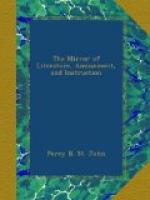Suetonius, relating the invasion of Britain by Vespasian, says, “Tricies cum hoste conflixit; duas validissimas gentes, superque xx oppida, et Insulam Vectem Britanniae proximam in deditionem redegit.” Cap. iv. Now, that one of these nations inhabited the Downs of Sussex, seems probable from their vicinity to the Isle of Wight, and in some measure confirmed by the lines and intrenchments still subsisting between Brighthelmston and Lewes, where the principal scene of action must have been, and bearing every Roman mark.
That there was a Roman station in this neighbourhood is admitted by the antiquarians, though its exact situation is not as yet ascertained. The Portus Aldurni, placed by the learned Selden at Aldrington, two miles to the west of Brighthelmston, is by the ingenious Tabor presumed to have been at East Bourne, eighteen miles to the east of it: yet there are many local and incidental circumstances belonging to this place, and which are wanting in those towns, that render a conjecture probable as to its having been a Roman station.
The Praepositus of the Exploratores, whose office was to discover the state and motions of the enemy, and who was certainly in this part of Sussex, could be no where more advantageously placed than in the elevated situations of the strong camps at Hollingsbury and White-Hawke, commanding a most extensive view of the whole coast from Beachy-Head to the Isle of Wight. The form of this town is almost a perfect square; the streets are built at right angles to each other, and its situation is to the south east, the favourite one among the Romans. To these may be added, that an urn has been some time ago dug up in this neighbourhood, containing a thousand silver denarii marked from Antoninus Pius to Philip, during which tract of time Britain was probably a Roman province. And, lastly, the vestiges of a true Roman via running from Shoreham towards Lewes, at a small distance above this town have been lately discovered by an ingenious gentleman truly conversant in matters of this nature.
The light sometimes obtained in these dark matters from a similitude of sounds in the ancient and modern names of places, is not to be had in assisting the present conjecture. Its ancient one, as far as I can learn, is no way discoverable; and its modern one may be owing either to this town’s belonging formerly to, or being countenanced in a particular manner by a Bishop Brighthelm, who, during the Saxon government of the island, lived in this neighbourhood: or perhaps may be deduced from the ships of this town having their helms better ornamented than those of their neighbouring ones.
It is true here are no hypocausts, Mosaic pavements, inscriptions, or any other delicate monuments of Roman antiquity,[4] that might corroborate in a stronger manner this supposition: these, if any such existed here, have been defaced by time, or destroyed by the undiscerning inhabitants of the place.




